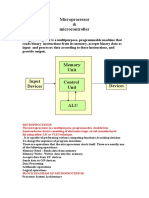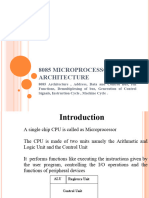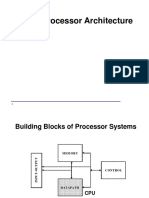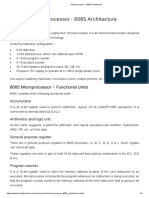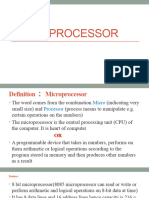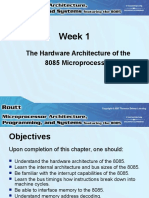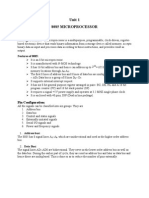0 ratings0% found this document useful (0 votes) 34 views20 pagesARM Architecture
Copyright
© © All Rights Reserved
We take content rights seriously. If you suspect this is your content,
claim it here.
Available Formats
Download as PDF or read online on Scribd
Processor System Architecture
The typical processor system consists of:
= CPU (central processing unit)
= ALU (arithmetic-logic unit)
= Control Logic
= Registers, etc...
= Memory
= Input / Output interfaces
Interconnections between these units:
= Address Bus
= Data Bus
= Control Bus�Microprocessor :-
¢ It is a programmable digital device, designed with
registers, flip-flops, Timing elements which has a set of
instructions, designed internally, to manipulate data and
communicate with peripherals.
+ The microprocessor can respond to external signals. It
can be interrupted, reset, or asked to wait to
synchronize with slower peripherals.
Operation Types in a Microprocessor
* All of the operations of the microprocessor can be
classified into one of three types:
o Microprocessor Initiated Operations
o Internal Operations
o Peripheral Initiated Operations�PONS
Microprocessor —- Initiated Operations and
8085 BUS Organization
Microprocessor Performs primarily four operations as a
part of communication process between MPU and
peripheral devices.
Memory Read : Reads data ( instructions) from memory
Memory Write : Writes data ( instructions) in to memory
/O Read : Accepts data from input devices.
/O Write : Sends data to output devices
To communicate with a peripheral, the MPU need to
perform following steps :-
. Identify the peripherals or the memory location (with its
address)
Transfer binary information ( data and instructions )
Provide timing or synchronization signals (control signals)
ce�Bus and CPU
Bus:
CPU: Core of the processor, where instructions are executed
A shared group of wires used for communicating
signals among devices
address bus:
the device and the location within the device that
is being accessed
data bus:
the data value being communicated
control bus:
describes the action on the address and data
buses
* High-level language: a=b+c
« Assembly language: add r1 r2 13 f oO J
a
* Machine language: 0001001010111010101�The 8085 Bus Structure
» The 8-bit 8085 CPU (or MPU — Micro Processing Unit)
communicates with the other units using a 16-bit
address bus, an 8-bit data bus and a control bus.
Address Bus
Memory
Real
ol iF Ee
Data Bus
Control Bus�The 8085 Bus Structure
Address Bus
Consists of 16 address lines: Ay — As
Operates in unidirectional mode:
* The address bits are always sent from the MPU to
peripheral devices in one direction , not reverse.
+ MPU uses the address bus to perform first function :
identifying a peripheral or a memory location
16 address lines are capable of addressing a Total of
216 = 65,536 (64k) memory locations.
Address locations: 0000 (hex) — FFFF (hex)
When the 8085 wants to access a peripheral or a
memory location, it places the 16-bit address on the
address bus and then sends the appropriate control
signals.
ca�The 8085 Bus Structure
Data Bus
= Consists of 8 data lines: Dy — D,
"Operates in bidirectional mode: The data bits are
sent from the MPU to peripheral devices, as well
as from the peripheral devices to the MPU.
= The MPU uses the data bus to perform second
function : Transfer binary information ( data and
instructions )
= Data range: 00 (hex) — FF (hex)
Control Bus
= Comprised of various single lines that carry
synchronization signals.
"The MPU uses such lines to perform third
function : Provide timing or synchronization
signals (control signals)�The 8085: CPU Internal Structure
The internal architecture of the 8085 CPU is capable
of performing the following operations:
= Store 8-bit data (Registers, Accumulator)
* Perform arithmetic and logic operations (ALU)
* Test for conditions (IF / THEN)
= Sequence the execution of instructions
= Store temporary data in RAM during execution�8085
MPU
D7
Do
Memory Read Operation
16-Bit Memory Address
Address Bus
Data Bus
Memory Decode
Memory Read
Instruction
and
Data
Memory
Chip�The Read Operation
* To read the contents of a memory location, the following
steps take place:
* The microprocessor places the 16-bit address of the
memory location on the address bus.
* The microprocessor activates a control signal called
“memory read” which enables the memory chip.
* The memory decodes the address and identifies the
right location.
* The memory places the contents on the data bus.
* The microprocessor reads the value of the data bus
after a certain amount of time.�Internal Data Operations
* The 8085 can perform a number of internal operations.
Such as: storing data, Arithmetic & Logic operations,
Testing for condition, etc.
* To perform these operations, the microprocessor
needs an internal architecture similar to the following:
11 —-—t
Accumulator A (8) Flag Register
B oo) c (8)
D (8) E (8)
H (8) L (8)
Stack Pointer (SP) a6)
Program Counter (PC) a6)
Data Bus Address Bus
Bidirectional Unidirectional�The Internal Architecture
Registers
= Six general purpose 8-bit registers: B, C, D, E, H, L
= They can also be combined as register pairs to
perform 16-bit operations: BC, DE, HL
= Registers are programmable (data load, move, etc.)
Accumulator
= Single 8-bit register that is part of the ALU
= Used for arithmetic / logic operations — the result is
always stored in the accumulator.
Flag Bits
= Indicate the result of condition tests.
" Carry, Zero, Sign, Parity, etc. Gea
* Conditional operations (IF / THEN) are executed
based on the condition of these flag bits.�The Internal Architecture
* The Program Counter (PC)
» This is a register that is used to control the sequencing
of the execution of instructions.
» This register always holds the address of the next
instruction.
» Since it holds an address, it must be 16 bits wide.
* The Stack pointer
» The stack pointer is also a 16-bit register that is used to
point into memory.
* The memory this register points to is a special area
called the stack.
» The stack is an area of memory used to hold data that
will be retreived soon.
» The stack is usually accessed in a Last In First Out
(LIFO) fashion.�Externally Initiated Operations
» External devices can initiate (start) one of the 4
following operations:
Reset
» All operations are stopped and the program
counter is reset to 0000.
2. Interrupt
» The microprocessor’s operations are
interrupted and the microprocessor executes
what is called a “service routine’.
This routine “handles” the interrupt, (perform
the necessary operations). Then the
microprocessor returns to its previous |)
operations and continues.�Externally Initiated Operations
3. Ready
» The 8085 has a pin called RDY. This pin is used by
external devices to stop the 8085 until they catch up.
» As long as the RDY pin is low, the 8085 will be in a
wait state.
4. Hold
The 8085 has a pin called HOLD. This pin is used by
external devices to gain control of the busses.
» When the HOLD signal is activated by an external
device, the 8085 stops executing instructions and
stops using the busses.
This would allow external devices to control the | ©)
information on the busses. Example DMA.�The 8085: CPU Internal Structure
8085
Microprocessor Data Bus
Ascii) | tig a
Flops! =e
‘Arithmetic/Logie Unit a
wv
Control =
Unit
Address Bus
Control Signals
Simplified block diagram�Example: Instruction Fetch Operation
All instructions (program steps) are stored in memory,
To run a program, the individual instructions must
be read from the memory in sequence, and executed,
= Program counter puts the 16-bit memory address of the
instruction on the address bus
* Control unit sends the Memory Read Enable signal to
access the memory
= The 8-bit instruction stored in memory is placed on the data
bus and transferred to the instruction decoder
= Instruction is decoded and executed ( a�Example: Instruction Fetch Operation
es 4F=—01001111
Microprocessor Data Bus
Internal Data Bus
Flag
A Instruction
Accumulator | | Flip-
Flops Decoder
[aatesistanc Uni | 2%
[vere]
ee LT
f=�Example: Instruction Fetch Operation�8085 Functional Block Diagram
7 a






